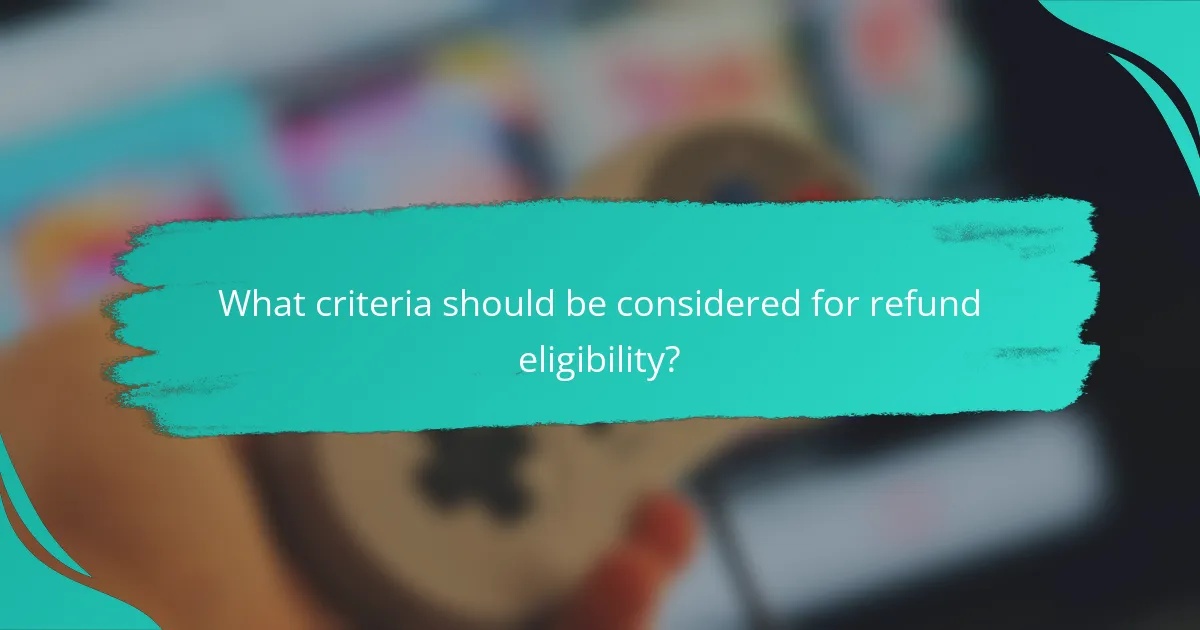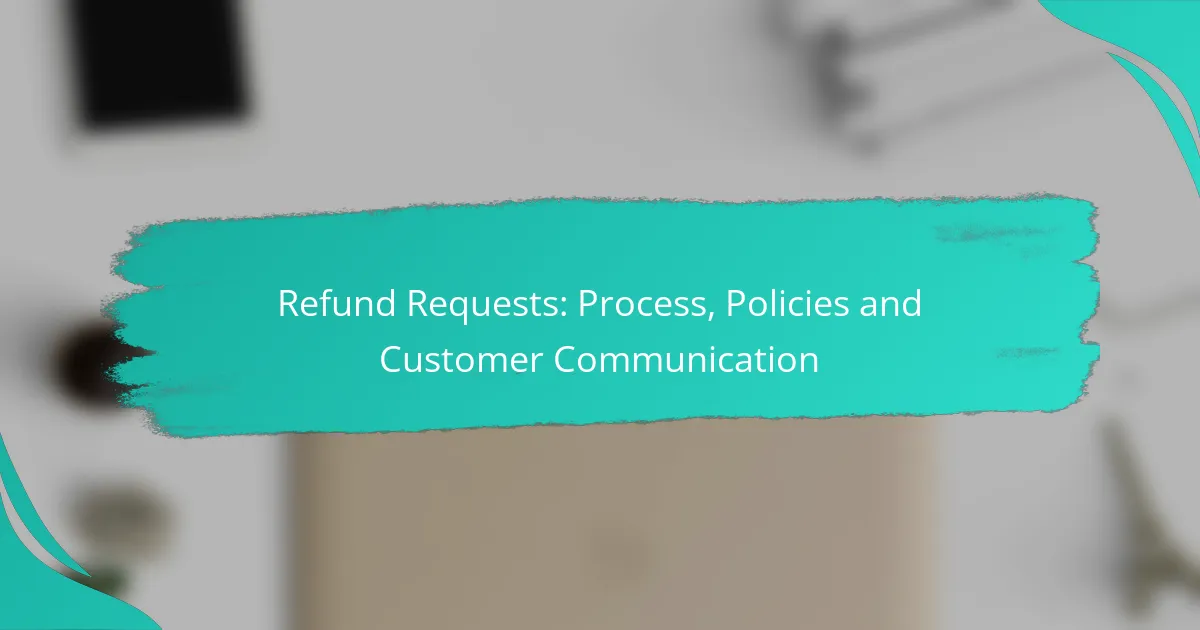Understanding the refund request process is crucial for both businesses and customers, as it ensures compliance with consumer protection laws and fosters trust. Clear communication about refund policies, especially for digital products, helps manage customer expectations and satisfaction. By addressing concerns with empathy and providing straightforward information, businesses can enhance their customer relationships and streamline the refund experience.

How to process refund requests in Canada?
To process refund requests in Canada, businesses must adhere to specific consumer protection laws and their own return policies. Clear communication with customers regarding the refund process is essential for maintaining trust and satisfaction.
Step-by-step refund processing
Begin by verifying the customer’s purchase details, including the date of purchase and the reason for the refund. Next, review your return policy to ensure the request complies with the stipulated conditions, such as time limits and product eligibility.
Once verified, initiate the refund through your payment processing system. Inform the customer about the expected timeline for the refund, which typically ranges from a few days to a couple of weeks, depending on the payment method used.
Common tools for processing refunds
Many businesses utilize payment processing platforms like PayPal, Stripe, or Square, which offer built-in refund features. These tools streamline the refund process and provide tracking for both the business and the customer.
Additionally, customer relationship management (CRM) software can help manage refund requests efficiently by keeping records and automating communication. Ensure that your chosen tools are compliant with Canadian regulations regarding consumer rights.
Best practices for digital products
For digital products, it’s crucial to clearly outline your refund policy before purchase. Many companies offer a limited refund window, often ranging from 14 to 30 days, to account for the immediate access customers have to the product.
Implementing a clear and user-friendly refund request form can enhance the customer experience. Always communicate promptly with customers about their requests and provide updates on the status of their refunds to foster transparency and trust.

What are the refund policies for digital products?
Refund policies for digital products typically vary by retailer but often allow for refunds within a limited timeframe after purchase. Customers should review the specific terms provided at the point of sale, as many digital products have unique conditions due to their intangible nature.
Standard refund policies in Canada
In Canada, standard refund policies for digital products usually allow customers to request a refund within a period of 14 to 30 days from the date of purchase. Retailers must clearly communicate their refund terms at the time of sale, ensuring that consumers understand their rights.
It is common for Canadian retailers to offer full refunds if the product is defective or not as described. However, if the customer has downloaded or accessed the product, the refund may be contingent upon specific conditions outlined in the retailer’s policy.
Exceptions for digital products
Many digital products, such as software subscriptions or online courses, may have stricter refund policies due to their nature. For instance, once a subscription is activated or a course is accessed, refunds may not be permitted, or only partial refunds may be available.
Additionally, promotional sales or discounted items often come with different refund conditions. Customers should always check the fine print regarding exceptions to avoid misunderstandings when seeking refunds for digital products.

How to communicate refund requests to customers?
Communicating refund requests to customers requires clarity and empathy. It’s essential to acknowledge their concerns and provide straightforward information about the refund process and policies.
Effective communication strategies
Utilize clear and concise language when addressing refund requests. Start by acknowledging the customer’s issue and express understanding of their situation. This builds rapport and shows that you value their experience.
Be transparent about the refund process, including timelines and any necessary steps the customer must take. For instance, inform them if they need to provide additional information or if there are specific forms to fill out.
Templates for refund request responses
Having response templates can streamline communication and ensure consistency. A basic template might include a greeting, acknowledgment of the request, a brief explanation of the refund process, and a closing statement offering further assistance.
For example, a simple template could be: “Dear [Customer Name], thank you for reaching out regarding your refund request. We understand your concern and are here to help. Please allow [X days] for processing your refund, and let us know if you have any questions.” This format provides clarity while maintaining a professional tone.

What are the common reasons for refund requests?
Common reasons for refund requests include issues with defective digital products and customer dissatisfaction. Understanding these reasons can help businesses address concerns effectively and improve customer experience.
Defective digital products
Refund requests for defective digital products typically arise when customers encounter issues such as software bugs, compatibility problems, or missing features. These defects can lead to frustration and a lack of trust in the product.
To handle such requests, businesses should have a clear policy outlining the process for reporting defects. This may include providing a support channel for troubleshooting or offering a replacement if the issue cannot be resolved. Quick responses can enhance customer satisfaction and reduce refund rates.
Customer dissatisfaction
Customer dissatisfaction can stem from unmet expectations regarding product performance, quality, or service. When customers feel that a product does not deliver on its promises, they are more likely to seek refunds.
To mitigate dissatisfaction, businesses should ensure transparent marketing and provide detailed product descriptions. Gathering customer feedback through surveys can also help identify common pain points and areas for improvement, ultimately reducing the likelihood of refund requests.

What criteria should be considered for refund eligibility?
Refund eligibility typically depends on the product or service type, the reason for the refund request, and the company’s specific policies. Customers should be aware of these criteria to ensure their requests are valid and likely to be approved.
Timeframe for refund requests
Most companies require refund requests to be submitted within a specific timeframe, often ranging from 14 to 30 days after purchase. It is crucial to check the exact policy of the company, as some may have stricter or more lenient deadlines.
For example, electronic goods might have a shorter return window compared to clothing or household items. Keeping receipts and documentation handy can help streamline the process.
Conditions for approval
Refund approval conditions often include factors such as product condition, reason for return, and adherence to company policies. Items must typically be unused, unopened, or in their original packaging to qualify for a full refund.
Additionally, some companies may require proof of purchase or a completed return form. Familiarizing yourself with these conditions can prevent delays and increase the chances of a successful refund request.

How to handle disputes regarding refunds?
To effectively handle disputes regarding refunds, start by understanding the customer’s concerns and the company’s refund policy. Clear communication and a structured approach can help resolve issues amicably and maintain customer satisfaction.
Steps for resolving disputes
Begin by reviewing the refund request and the reasons for the dispute. Gather all relevant information, including transaction details, communication history, and the company’s refund policy. This will provide a solid foundation for addressing the issue.
Next, communicate directly with the customer. Acknowledge their concerns, and provide a clear explanation of the refund policy as it applies to their situation. If possible, offer solutions such as partial refunds, exchanges, or store credit to reach a mutually agreeable outcome.
Escalation processes
If the dispute cannot be resolved at the initial level, follow the company’s escalation process. This typically involves involving a supervisor or a dedicated customer service team. Ensure that all documentation is organized and accessible to facilitate a smooth transition.
During the escalation, maintain open lines of communication with the customer. Inform them of the steps being taken and provide timelines for resolution. This transparency can help alleviate frustration and demonstrate the company’s commitment to resolving the issue.

What are the emerging trends in refund policies?
Emerging trends in refund policies reflect a growing emphasis on customer satisfaction and transparency. Companies are increasingly adopting flexible refund options and clear communication strategies to meet evolving consumer expectations.
Impact of consumer rights legislation
Consumer rights legislation is shaping refund policies by mandating clearer terms and conditions. Regulations often require businesses to provide refunds within a specified timeframe, typically ranging from 14 to 30 days, depending on the jurisdiction.
For example, in the European Union, the Consumer Rights Directive ensures that customers can return goods purchased online within 14 days for a full refund. Businesses must stay informed about local laws to avoid penalties and maintain customer trust.
Shifts in customer expectations
Customers now expect hassle-free refund processes and prompt communication. Many consumers prefer online platforms that offer instant refunds or easy return procedures, reflecting a shift towards convenience and efficiency.
To meet these expectations, businesses should streamline their refund processes, providing clear instructions and timely updates. Implementing automated systems can help manage requests efficiently, reducing wait times and enhancing customer satisfaction.
